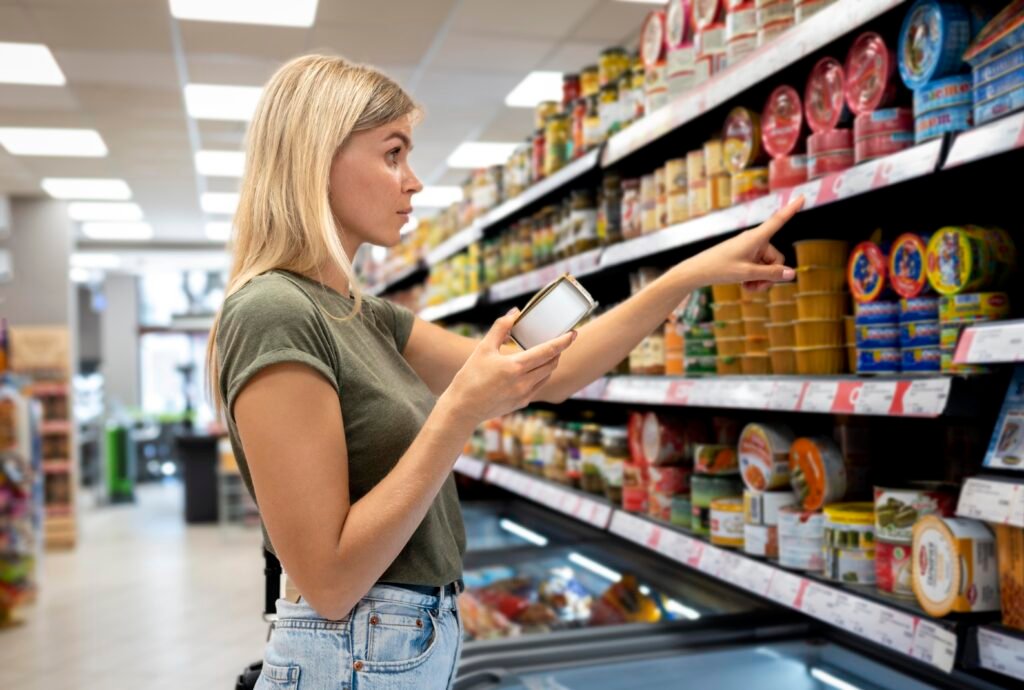As per the SkyQuest technology report, the global FMCG Market size was valued at USD 107.46 Billion in 2022 and is poised to grow from USD 111.39 Billion in 2023 to USD 148.51 Billion by 2031, at a CAGR of 3.66% during the forecast period (2024-2031).
But What Are Fast-Moving Consumer Goods or FMCG?
Fast-moving consumer goods (FMCG) are products that:
- Sell quickly
- Have a high price
- Have a short shelf life.
Understanding the FMCG industry is crucial for both businesses and consumers.
On one hand, the firms may use their understanding of FMCG to create effective marketing strategies that respond to customer wants.
On the other hand, consumers can make much more informed choices about their FMCG purchases.
FMCG Definition & Examples:
FMCG relates to products in the market sold quickly and at a reasonably low price. These are usually not long-lasting and are also regarded as Consumer Package Goods (CPG). From waking up and using toothpaste in the morning to drinking a glass of milk before bed you are surrounded with these goods. This industry is characterized by high-volume sales, quick inventory turnover, and various products catering to consumer needs.
What are the broad categories that fall under FMCG products?
- Food and Beverages: This particular category includes all the products you eat and drink like packaged food, snacks, bottled water, soft drinks, dairy products, etc.
- Personal care items: Includes self-care products like Toothpaste, soap, shampoo, cosmetics, shaving products, etc.
- Household cleaning products: Such as Detergents, disinfectants, air fresheners, surface cleaners, etc.
- Over-the-counter medications: Regular medication like pain relievers, allergy medications, cold and flu remedies, etc.
- Pet supplies: Like pet food, treats, grooming products, litter, etc.
The FMCG Industry Landscape:
The market size that the FMCG industry holds is enormous. But recently, the FMCG industry faced a slight decline. In 2023, for instance, American consumers spent 10% more on groceries but bought 4% fewer items.
FMCG Trends:
The FMCG innovation led to the emergence of the following trends:
- Sustainable FMCG practices: Consumers’ climate change awareness is growing, leading to a shift in their preferences and prioritizing social responsibility. FMCG companies are responding to it by rethinking their packaging and product materials.
- Digitalization: Digital transformation is gaining momentum in the FMCG sector. Brands are establishing connections with customers through a variety of online channels as well. It also allows FMCG brands to better engage with customers and convert one-time buyers into repeat customers.
- FMCG E-Commerce: E-commerce in the FMCG sector is witnessing a surge in both B2C and B2B sales. The COVID-19 pandemic has accelerated this shift, altering consumer shopping habits towards online channels like Amazon and Flipkart.
- AI: For immediate assistance, large FMCG industries incorporate chatbots in their customer support.
- 3D Printing: FMCG companies utilize 3D printing for various purposes, including prototyping, designing, tooling, and scaling production sustainably.
Key Players: Top FMCG brands
Below are the top FMCG brands we know today:
- Procter & Gamble: An American consumer goods company that makes a variety of personal care products.
- Unilever: A British FMCG company that makes beauty products, cereals, energy drinks, healthcare products, and other products used daily.
- Nestlé: A Swiss multinational company, that focuses on food and drink processing. It makes a wide range of products, including candy, infant formula, bottled water, dairy products, and cereals.
This market is not limited to these key players. Start-ups and small local businesses are building themselves a niche, that caters to specific consumer preferences.
FMCG Distribution Channels:
From traditional to digital, FMCG products can reach businesses and consumers through various distribution channels. These channels include-
- Traditional Retail Stores: Supermarkets, retail businesses, MSMEs, convenience stores, etc. remain a dominant force in the distribution of FMCG products.
- Online Platforms: Nowadays, consumers use E-commerce websites more extensively as they offer consumers convenience and wider product selection.
- Wholesale Markets: These markets deal with bulk buyers like restaurants and hotels, ensuring a steady supply of FMCG goods.
- Direct-to-Consumer Sales: Through subscriptions or online marketplaces, some brands sell directly to consumers instead of using traditional channels.
Why Does FMCG Matter to Consumers?
FMCG products are the essentials for our daily lives. These products offer:
- Convenience: These commodities help in saving time and effort (such as ready-to-use products).
- Affordability: FMCG goods are products that are accessible and affordable to a wide range of consumers.
- Variety: As the industry falls under perfect competition, it leaves consumers with a wide range of product selections.
These products make the lives of consumers easy. As customers are evolving, these products are becoming more of a necessity.
Why Does FMCG Matter to Businesses?
The FMCG industry is a dynamic and competitive space. The reasons why FMCG matters to businesses are as follows:
- Stable demand: These products mostly include a wide range of daily essential items. Hence, no matter how the market turns, the demand for these products will always remain stable.
- Frequent purchase: As these products don’t have much shelf-life, they sell quickly. This helps businesses have a good amount of consumers in-store stepping and getting traffic on e-commerce sites.
- Profit Margins: Since the FMCG industry lies under perfect competition, the profit margin depends on the sales of goods. The more you sell the more you earn.
What are the Challenges in the FMCG Sector?
- Huge Competition: This industry falls under perfect competition. Easy entry, easy exit, and a very high competition. Global brands compete intensely for market share, requiring constant innovation and strategic marketing.
- Price Sensitivity: It is not easy to fluctuate prices in this industry. Here, the consumers are increasingly price-conscious and prone to switch, putting pressure on profit margins.
- Keeping up with sustainability: The current demand of consumers has shifted to sustainable products. Nowadays, consumers want eco-friendly products from FMCG companies.
The Future of FMCG:
The future of the fast-moving consumer goods industry depends on various factors that affect the trends of the market. Following are the opportunities FMCG can focus on for future growth:
- Rising E-commerce Sector: Recently, online shopping has become a trend because of increasing convenience, personalized product recommendations, and home delivery. FMCG companies can effectively use e-commerce platforms and position themselves for future growth.
- Trend of Personalized Marketing: FMCG companies are increasingly utilizing data analytics to personalize marketing messages and product offerings.
- Tech Advancements: As Technological advancements continue to evolve the FMCG landscape, measures taken by businesses in the same direction will help them to strengthen their presence.
Conclusion
The FMCG industry is a fascinating and ever-evolving space essential for both companies and consumers. Understanding this sector helps businesses to develop effective marketing strategies and consumers to make more informed choices. Many opportunities lie ahead for the FMCG Industry. We at Falcon Gallant are constantly aiming to meet the evolving needs of this market.



